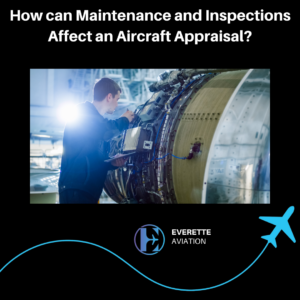Maintenance and inspections play a crucial role in determining the value of an aircraft. The condition of an aircraft significantly influences its market worth, and potential buyers or lenders consider the maintenance history when making decisions.

Appraisers assess the completeness and accuracy of maintenance records. Thorough and well-documented records contribute positively to the aircraft’s value.
Compliance with scheduled maintenance items, such as routine inspections, engine overhauls, and component replacements, reflects positively on the aircraft’s overall health.
Adherence to aviation regulations is critical. An aircraft that consistently meets or exceeds regulatory standards tends to have a higher appraisal value. Appraisers consider whether the aircraft complies with all relevant ADs, as non-compliance could affect both safety and value.
An aircraft that has undergone recent major inspections or overhauls may be appraised higher due to increased reliability and extended operational life.
The reputation of the maintenance facility conducting the inspections and overhauls can influence the appraisal. High-quality work from reputable facilities adds value.
Modern avionics systems can enhance an aircraft’s value. Appraisers consider the functionality and currency of avionics equipment.
Upgrades that improve the aircraft’s performance or fuel efficiency may positively impact its appraisal.
The overall physical condition of the aircraft, including the paint, interior, and structural components, affects its value.
The remaining life of major components, such as engines and landing gear, is assessed to determine their impact on the appraisal.
The presence of corrosion can significantly impact an aircraft’s value. Appraisers evaluate the extent of corrosion and the steps taken to address it.
Ensuring the structural integrity of the aircraft is crucial. Damage to structural components can have a negative effect on the appraisal.
A thorough pre-purchase inspection can instill confidence in potential buyers or lenders. It provides a detailed assessment of the aircraft’s condition and can influence the appraisal outcome.
Discovering and addressing hidden issues during pre-purchase inspections can prevent surprises later in the transaction process.
The way an aircraft has been operated, including the types of missions and environments it has been exposed to, can impact its appraisal value.
Higher flight hours and cycles generally lead to more wear and tear, potentially affecting the aircraft’s value.
Appraisers may consider future maintenance requirements and associated costs. An aircraft with upcoming expensive maintenance items may have a lower appraisal value.
In summary, maintenance and inspections are integral to aircraft appraisal as they provide a comprehensive picture of an aircraft’s health, reliability, and compliance with regulatory standards. A well-maintained aircraft with a documented history of care and attention is likely to command a higher appraisal value in the market.








